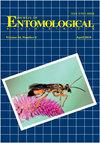Susceptibility of a Mexican Field-Collected Wild Population of Diaphorina citri (Hemiptera: Liviidae) to Selected Insecticides
IF 0.7
4区 农林科学
Q4 ENTOMOLOGY
引用次数: 0
Abstract
Abstract The Asian citrus psyllid, Diaphorina citri (Kuwayama) (Hemiptera: Liviidae), is a severe pest of citrus orchards worldwide. Its control is based mainly on the use of conventional insecticides, and resistance to many of those compounds is widespread. Phenotypic bioassays to detect resistance compare the response of a field-collected population with a laboratory-reared population that is susceptible to insecticides. This comparison usually does not involve a susceptible field-collected counterpart since its existence is currently rare. We found an isolated field population of D. citri living on a wild host, orange jasmine (Murraya paniculata [L.] Jack). Considering its lifetime fly capacity, gene flow with any insecticide-treated population was nonexistent or negligible. Thus, we determined the response in fourth-instar nymphs and unsexed 2- to 5-d-old adults in bioassays of commercial formulations of the commonly used insecticides chlorpyrifos, malathion, imidacloprid, and spinosad. In the bioassays, insects were placed on leaf discs previously immersed for 10 s in the respective insecticide concentrations. For adults, the lowest concentration–mortality response was with chlorpyrifos (lethal concentration 50 [LC50] of 0.72 mg L-1 and lethal concentration 95 [LC95] of 1.02 mg L-1). The highest toxicity response was with malathion (LC95 of 0.05 mg L-1). The highest toxicity response with fourth-instar nymphs was observed with spinosad (LC50 of 0.007, LC95 of 0.021 mg L-1). The estimated LC50 and LC95 values for chlorpyrifos, malathion, and spinosad were lower than those documented worldwide for these insecticides in susceptible populations of D. citri.墨西哥田间采集的柑橘蚜蝇(半翅目:蚜科)野生种群对选定杀虫剂的敏感性
摘要亚洲柑橘木虱(Diaphorina citri (Kuwayama))(半翅目:Liviidae))是世界范围内柑橘果园的严重害虫。其控制主要基于使用常规杀虫剂,而对其中许多化合物的抗药性是普遍存在的。用于检测抗性的表型生物测定将田间采集的种群与实验室饲养的对杀虫剂敏感的种群的反应进行比较。这种比较通常不涉及易受影响的现场收集的对应物,因为它的存在目前很少。我们发现了一个孤立的野外种群,生活在野生宿主橙茉莉(Murraya paniculata [L.])上。]杰克)。考虑到其终生飞行能力,任何杀虫剂处理过的种群的基因流动都不存在或可以忽略不计。因此,我们对常用杀虫剂毒死蜱、马拉硫磷、吡虫啉和spinosad的商业配方进行生物测定,确定了四龄若虫和2- 5天大的无性成虫的反应。在生物测定中,昆虫被放置在叶片上,在不同浓度的杀虫剂中浸泡10 s。毒死蜱对成虫的浓度-死亡率反应最低(致死浓度50 [LC50]为0.72 mg L-1,致死浓度95 [LC95]为1.02 mg L-1)。马拉硫磷(LC95为0.05 mg L-1)的毒性反应最高。四龄若虫对spinosad的毒性反应最高(LC50为0.007,LC95为0.021 mg L-1)。毒死蜱、马拉硫磷和spinosad的LC50和LC95值低于世界范围内记录的这些杀虫剂在柑橘螟易感种群中的LC50和LC95值。
本文章由计算机程序翻译,如有差异,请以英文原文为准。
求助全文
约1分钟内获得全文
求助全文
来源期刊
CiteScore
1.20
自引率
11.10%
发文量
40
审稿时长
>12 weeks
期刊介绍:
The Journal of Entomological Science (ISSN 0749-8004) is a peer-reviewed, scholarly journal that is published quarterly (January, April, July, and October) under the auspices of the Georgia Entomological Society in concert with Allen Press (Lawrence, Kansas). Manuscripts deemed acceptable for publication in the Journal report original research with insects and related arthropods or literature reviews offering foundations to innovative directions in entomological research

 求助内容:
求助内容: 应助结果提醒方式:
应助结果提醒方式:


